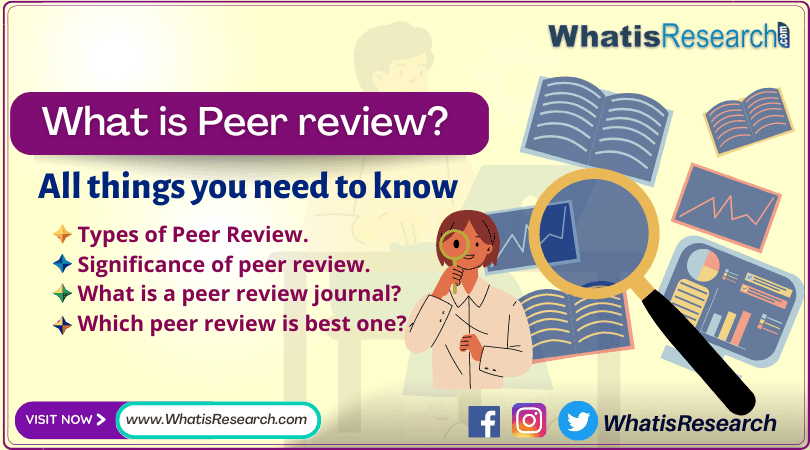Are you looking forward to publishing your research paper in a peer-reviewed journal or you might be looking to understand the peer review process? Then here in this article, we will explain What is peer review? All things you need to know. Peer review is mostly used in the journsl’s pre publication process. There are many types of Peer review process which we will explain in this article.
What is peer review? All things you need to know
What is peer review?
Before going deeper let’s understand what is peer review.
Peer review is a process that most journal publisher follows to select one paper. It helps the editor of the journal to take a decision regarding to selection or rejection of a manuscript got submitted.
The peer review process is followed to determine the quality and validity of the submitted research manuscript. The major role of the process is the maintain the integrity of the scientific research and remove poor research work.
The peer review process motivates the authors to maintain the originality of the research paper. The submitted articles going through this process add value to it.
Under the editorship of Henry Oldenburg (1618–1677), the Philosophical Transactions of the Royal Society is regarded to have been the first journal to formally introduce the peer review process.
Peer review definition
Peer review is a process through which, manuscripts get evaluated by expert reviewers in the same field before publication in a journal.
What is the significance of peer review?
It acts as a filter for high-quality journals. This helps the journal’s editor to filter out peer-quality research works. Peer reviews comment to the author on how to improve the quality of the manuscript and also checks the error before publication.
Types of peer review
There are different types of peer review processes. Generally, we categorize them into 5 types. Let’s discuss them one by one.
Single anonymized
This is the most common type of peer review which is also known as “Single blind peer review”. Here the reviewer knows about the author. But you as an author will not know the reviewer’s identity.
Since the reviewer will stay anonymous throughout the process, they can be completely honest with their feedback on the paper.
But here in this type of review process, one problem lies which is the Risk of reviewer unconscious bias; they might evaluate the work depending on the author’s details without even realizing it.
Double anonymized
Most researchers and research organizations prefer this type of review. Here the chance of bias is reduced. Here the reviewer and the author do not know identity of each other at any time. This is also known as “Double blind Peer review”.
Along with many advantages, it has one major issue. It is impossible to ensure the author’s confidentiality. For instance, if the reviewer was already acquainted with their work or knew someone was working on a specific subject.
Open peer review
Here the identity of the reviewer and the author is known to each other. Here the identity of the reviewer and the author is reviled at some point in the review process.
There are worries that under an open format where their identity and report will be released, researchers who are invited to review may be less motivated to do so. Here in this process, the author may revive more constructive comments about the paper.
Transparent Peer review
In this process, the reviewer’s comments can be published along with the paper. The reviews of the paper can share their identity to publish along with the paper.
According to Elsevier many Elsevier journals, therefore, publish the name of the article’s handling editor on the published paper on ScienceDirect. Some journals also provide details about the number of reviewers who reviewed the article before acceptance.
Post publication
As the name suggests the review done after the publication of the paper. The paper gets published after some basic checks by the editorial team. Then the reviewers invited to review the paper and post their comments.
Not many publishers follow this review process. If your paper addresses a contentious issue, it can draw a lot of comments that aren’t always moderated.
Currently, F1000Research follows this type of review process. Peer review reports are published along with the full identities and affiliations of the reviewers and are kept with the article even if it is included in databases like PubMed and Scopus. Your study will be released, citeable, and DOI. The approval status that reviewers choose when evaluating an article directly affects whether it will be indexed.
Must read: How to choose the right journal for publication?
What are the 3 kinds of peer review?
As we discussed in this article, the three types of peer reviews mostly followed are Single-blind peer review, Double blind Peer review, and Open peer review.
The process of peer review
The peer review process follows the following steps to complete
Step-1: The author submits the manuscript to journal
Step-2: Editorial office assessment: To ensure that it contains the necessary sections and stylistic elements, the journal compares the paper’s content and arrangement to its Author’s Guidelines. At this time, there is no evaluation of the paper’s quality.
Step-3: Editor’s assessment and decision: After the initial round review and editorial office assessment if the papers suits to journals then the editor assigns the external reviewers for the paper.
Stpe-4: Response to Invitations: Once the reviewers accept the invitation to review then the review process starts or else the editor has to find other editors on the same topic.
Step-5: Review completed and comments submitted to the editor.
Step-6: The Editor takes the decision based on the review comments to accept or reject or to as the author for more modification and rectification.
Step-7: If no modification or rectification is required then it is accepted.
Must read: 5 Best tips for choosing the right Journal
What is peer review journal?
The journal which follows the peer review process to select the research paper is called a peer-reviewed journal. It might follow Single blind peer review,Double blind Peer review or Open peer review model to selected the paper.
Now most universities and colleges ask for peer reviewed journals. It’s the requirement for the degree for the students if you are pursuing your PhD, Masters or bachelors or even you are an academician. You need to find the a peer reviewed journal to publish your paper.
What is the highest standard of peer review?
Double bling peer review process is considered as the highest stand in the peer review process.
Final words
So this is all about the What is peer review? All things you need to know. As an author or researcher, you need to check your requirement for the peer review process and find the journal which follows the process.







